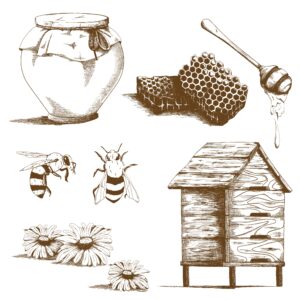The Victorian era in Britain was marked by tremendous advancements in various fields, from industry to culture. However, one aspect that often goes unnoticed is the history of beekeeping during this period. Bees played a vital role in Victorian agriculture and society, and the practice of beekeeping underwent significant changes. In this blog post, we will delve into the buzzing beginnings of Victorian beekeeping, exploring its historical significance and how it evolved over time.

The Importance of Bees in Victorian Britain
Bees held a unique place in Victorian Britain. They were not just insects; they were essential contributors to the agricultural landscape. The importance of bees in pollinating crops and producing honey and beeswax was well understood during this time. Honey was a popular sweetener, and beeswax had various uses, from candle-making to crafting cosmetics and furniture polish.
Early Victorian Beekeeping
The early Victorian era saw beekeeping still in its traditional form, often practiced by rural communities. Skeps, dome-shaped hives made from straw or wicker, were commonly used to house bees. Beekeepers would tend to their hives, extracting honey and beeswax using simple methods. However, this changed as the century progressed.
The Langstroth Hive Revolution
One of the most significant developments in Victorian beekeeping was the introduction of the Langstroth hive. In 1851, the American clergyman and apiarist Lorenzo Lorraine Langstroth invented a beehive with removable frames, a design that allowed beekeepers to inspect their hives without disturbing the bees. This innovation revolutionized beekeeping, making it more accessible and efficient.
The British beekeeping community quickly adopted the Langstroth hive, which improved honey production and the overall health of bee colonies. It also paved the way for modern beekeeping practices that we see today.

The Victorian Beekeeping Boom
With the adoption of the Langstroth hive, beekeeping became a popular hobby among the Victorian middle class. Beekeeping associations and societies were established, and numerous books and articles on beekeeping were published. Beekeepers exchanged knowledge and best practices, leading to improved bee health and increased honey production.
The Role of Women in Victorian Beekeeping
Victorian beekeeping was not limited to men. Women, especially those in rural communities, actively participated in beekeeping. They played a significant role in the care of hives and the extraction of honey and beeswax. Some women even authored beekeeping manuals and contributed to the dissemination of knowledge in this field.
The Impact on Victorian Society
Beekeeping, besides its agricultural significance, also had a cultural impact in Victorian Britain. It symbolized industry, thrift, and the moral virtues of hard work and cooperation with nature, making it a popular pastime among the Victorians. Bees and hives were also featured in art, literature, and fashion of the time, symbolizing a connection to nature and the rural way of life.
The history of beekeeping in Victorian Britain is a fascinating journey that reflects the evolving relationship between humans and nature during this era. From traditional skeps to the revolutionary Langstroth hive, Victorian beekeeping evolved significantly, becoming a popular hobby and contributing to the agricultural and cultural landscape of the time. The legacy of Victorian beekeeping lives on in the modern practices that continue to depend on the industrious and vital work of these remarkable insects today.